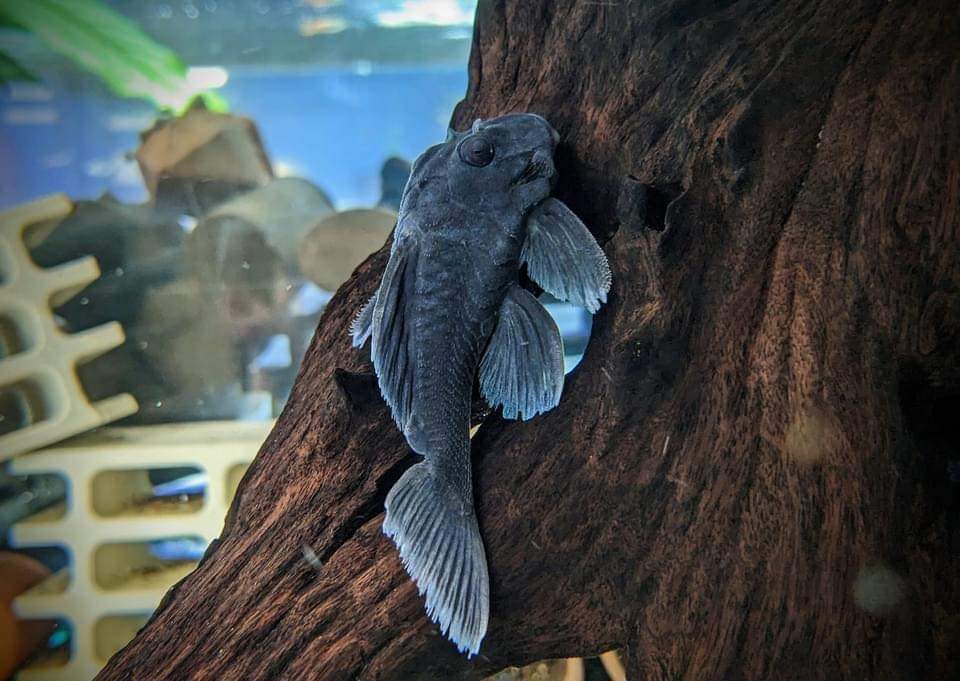Your basket is currently empty!
The Blue Panaque L239, also known as the Blue Flash Pleco or Blue Panaque Pleco, is a striking freshwater fish that captivates aquarists with its vibrant colouration and unique behaviour. Known for their dazzling blue hue and distinct body shape, these plecos make an excellent addition to any aquarium. At Only Fins in Staffordshire, we are dedicated to providing you with the knowledge and resources needed to care for this extraordinary species. This comprehensive guide will cover everything you need to know about the Blue Panaque L239, from its natural habitat and dietary requirements to tank setup and compatibility, ensuring your aquarium is beautiful and thriving.
Overview of the Blue Panaque L239
The Blue Panaque L239 (Baryancistrus beggini), often called the Blue Phantom Pleco, is a member of the Loricariidae family and is native to the Rio Orinoco basin in Venezuela. This fish is renowned for its vivid blue colouration and small white spots, giving it a “starry night” appearance. The Blue Panaque L239 typically reaches 6 to 8 inches (15 to 20 cm), making it suitable for medium-sized aquariums. Their peaceful nature and stunning appearance make them a favourite among pleco enthusiasts.
Ideal Tank Setup for Blue Panaque L239
Creating a suitable environment for Blue Panaque L239 involves replicating their natural habitat, focusing on tank size, water quality, and aquascaping to meet their needs:
Tank Size: A minimum of 50 gallons is recommended for a single Blue Panaque L239. Larger tanks are preferable for housing multiple plecos or additional tank mates.
Aquascape: Design a tank with plenty of hiding spots and open swimming areas. Driftwood, rocks, and caves create a natural and secure environment. Adding live plants like Anubias and Java fern can enhance the tank’s aesthetic and provide additional hiding places.
Substrate: Use a soft sand or fine gravel substrate to mimic their natural riverbed habitat and prevent damage to their delicate barbels.
Water Parameters:
Temperature: 74-82°F (23-28°C)
pH Level: 6.5-7.5
Water Hardness: Soft to moderately hard (5-15 dGH)
Maintaining stable water conditions is crucial for the health of Blue Panaque L239. Use a high-quality filtration system and perform regular water changes to ensure clean, well-oxygenated water. These plecos prefer moderate water flow, so consider adding a powerhead or adjusting the filter output to create the desired current.
Diet and Feeding
Blue Panaque L239 are primarily herbivorous but will accept a varied diet to maintain their health and vibrant colouration. Providing a balanced diet includes:
Algae Wafers: Offer high-quality sinking algae wafers as a staple diet to provide essential nutrients.
Vegetables: Supplement with blanched vegetables such as zucchini, cucumber, and spinach to add variety and nutrition.
Occasional Protein: Include occasional protein sources like bloodworms or brine shrimp to ensure a well-rounded diet.
Feed Blue Panaque L239 once or twice daily, providing enough food to be consumed within a few hours. Remove any uneaten food to maintain water quality and prevent overfeeding.
Social Behavior and Compatibility
Blue Panaque L239 are generally peaceful and can coexist with various tank mates. However, it is essential to choose compatible species to ensure a harmonious community:
Suitable Tank Mates: Tetras, rasboras, Corydoras catfish, and other non-aggressive species that thrive in similar water conditions make excellent companions for Blue Panaque L239.
Avoid Aggressive or territorial species that may harass or compete with plecos for food and space.
Providing ample hiding spots and territories can help reduce stress and promote peaceful interactions among your fish. Monitoring tank dynamics and adjusting the aquascape or tank mates is also essential.
Breeding Blue Panaque L239
Breeding Blue Panaque L239 in captivity is challenging due to its specific environmental requirements and territorial behaviour. To encourage breeding, maintain optimal water conditions and provide plenty of hiding spots and caves for spawning. Simulating seasonal changes by adjusting water temperature and flow can help trigger breeding behaviour.
If breeding is successful, the male will guard the eggs until they hatch, typically taking about a week. Raising the fry requires careful attention to water quality and a nutritious diet of finely crushed algae wafers and vegetables. Providing a separate breeding tank or using a breeder box can increase the chances of successful spawning and fry survival.
Conclusion
The Blue Panaque L239 is a captivating and rewarding addition to any aquarium, offering beauty and intrigue. By understanding its specific care requirements and creating a suitable habitat, you can enjoy the company of this mesmerising fish in your own home. We’re committed to helping you succeed in your aquatic endeavours at Only Fins in Staffordshire. Visit our store or contact us today for all your aquarium needs and expert guidance on caring for your Blue Panaque L239.


Leave a Reply